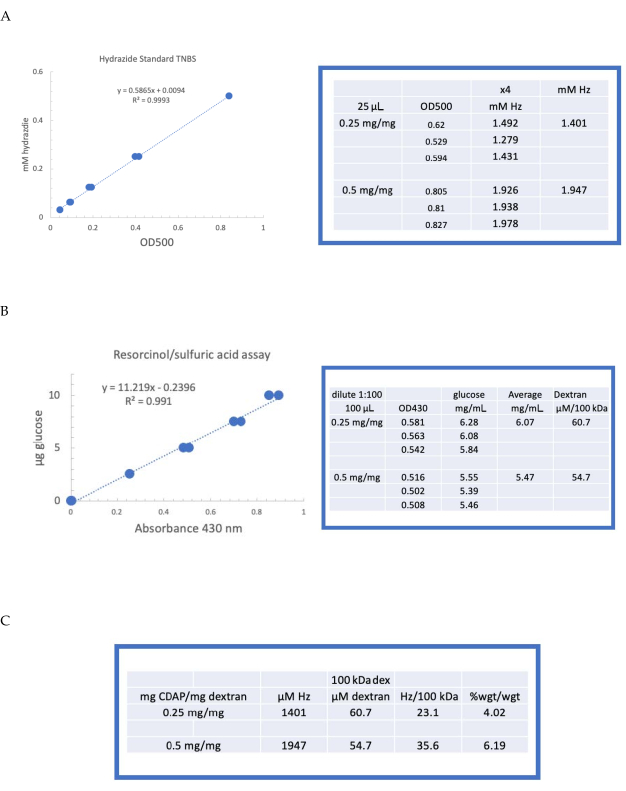Abstract
Immunology and Infection
Ativação e Conjugação de Polissacarídeos Solúveis usando 1-Cyano-4-Dimethylaminopyridine Tetrafluoroborate (CDAP)
ERRATUM NOTICE
Important: There has been an erratum issued for this article. Read more …Vacinas conjugais são avanços notáveis na vacinação. Para a preparação de vacinas conjugadas de polissacarídeos, os polissacarídeos podem ser convenientemente funcionais e ligados a proteínas portadoras de vacinas usando tetrafluoroborate de 1-ciano-4-dimetilaminopyridina (CDAP), um reagente de cianeto fácil de lidar. O CDAP ativa polissacarídeos reagindo com grupos de hidroxil de carboidratos no pH 7-9. A estabilidade e a reatividade do CDAP são altamente dependentes do pH. O pH da reação também diminui durante a ativação devido à hidrólise do CDAP, o que faz do bom controle de pH a chave para a ativação reprodutível. O protocolo original de ativação do CDAP foi realizado à temperatura ambiente em soluções de pH 9 não oferecidas.
Devido à reação rápida sob esta condição (<3 min) e à queda rápida de pH da hidrólise rápida do CDAP, foi desafiador ajustar-se rapidamente e manter o pH de reação alvo no curto espaço de tempo. O protocolo aprimorado descrito aqui é realizado a 0 °C, o que retarda a hidrólise cdap e amplia o tempo de ativação de 3 min para ~15 min. Dimethylaminopyridina (DMAP) também foi usado como um tampão para pré-ajustar a solução de polissacarídeo ao pH de ativação de destino antes de adicionar o reagente CDAP. O maior tempo de reação, juntamente com a hidrólise CDAP mais lenta e o uso do buffer DMAP, facilita a manutenção do pH de ativação durante toda a duração do processo de ativação. O protocolo melhorado torna o processo de ativação menos frenético, mais reproduzível e mais agradável de escalar.
Erratum
Erratum: Activation and Conjugation of Soluble Polysaccharides using 1-Cyano-4-Dimethylaminopyridine Tetrafluoroborate (CDAP)An erratum was issued for: Activation and Conjugation of Soluble Polysaccharides using 1-Cyano-4-Dimethylaminopyridine Tetrafluoroborate (CDAP). A figure was updated.
Figure 4 was updated from:

Figure 4: Representative results for CDAP activation of dextran. Typical standard curves for the (A) resorcinol/sulfuric acid and (B) TNBS assays. The assay results for dextran activated with 0.25 and 0.5 mg CDAP/mg dextran are shown. Glucose was used as the standard for the resorcinol assay. Dextran, in mg/mL, is divided by 100 kDa to give a molar concentration. The hydrazide concentration is determined using ADH as the standard and the results expressed as µM Hz. (C) Calculation of hydrazide: dextran ratios.The level of derivatization was calculated as hydrazides per 100 kDa of dextran to facilitate the comparison between polymers of different average molecular weights. The % weight ratio of g ADH/g dextran was calculated using a MW of 174 g/mole for ADH. Please click here to view a larger version of this figure.
to:

Figure 4: Representative results for CDAP activation of dextran. Typical standard curves for the (A) resorcinol/sulfuric acid and (B) TNBS assays. The assay results for dextran activated with 0.25 and 0.5 mg CDAP/mg dextran are shown. Glucose was used as the standard for the resorcinol assay. Dextran, in mg/mL, is divided by 100 kDa to give a molar concentration. The hydrazide concentration is determined using ADH as the standard and the results expressed as µM Hz. (C) Calculation of hydrazide: dextran ratios.The level of derivatization was calculated as hydrazides per 100 kDa of dextran to facilitate the comparison between polymers of different average molecular weights. The % weight ratio of g ADH/g dextran was calculated using a MW of 174 g/mole for ADH. Please click here to view a larger version of this figure.
ABOUT JoVE
Copyright © 2024 MyJoVE Corporation. All rights reserved